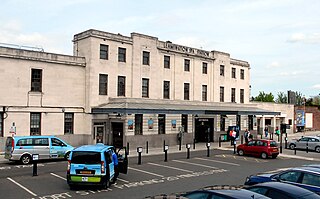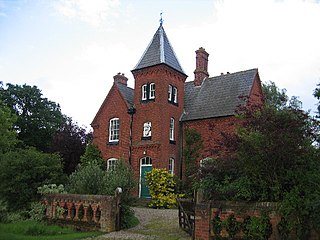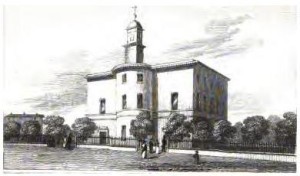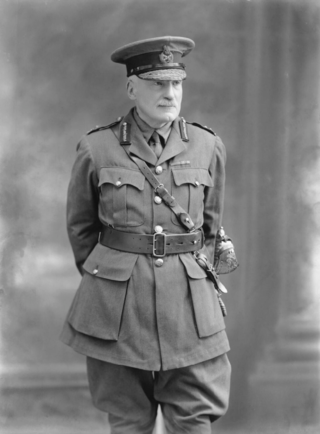Related Research Articles

Royal Leamington Spa, commonly known as Leamington Spa or simply Leamington, is a spa town and civil parish in Warwickshire, England. Originally a small village called Leamington Priors, it grew into a spa town in the 18th century following the popularisation of its water which was reputed to have medicinal qualities. In the 19th century, the town experienced one of the most rapid expansions in England. It is named after the River Leam, which flows through the town.

Warwick is a market town, civil parish and the county town of Warwickshire in the Warwick District in England, adjacent to the River Avon. It is 9 miles (14 km) south of Coventry, and 19 miles (31 km) south-east of Birmingham. It is adjoined with Leamington Spa and Whitnash.

Warwickshire is a ceremonial county in the West Midlands of England. It is bordered by Staffordshire and Leicestershire to the north, Northamptonshire to the east, Oxfordshire and Gloucestershire to the south, and Worcestershire and the West Midlands county to the west. The largest settlement is Nuneaton and the county town is Warwick.

Warwick is a local government district in Warwickshire, England. It is named after the historic county town of Warwick, which is the district's second largest town; the largest town is Royal Leamington Spa, where the council is based. The district also includes the towns of Kenilworth and Whitnash and surrounding villages and rural areas. Leamington Spa, Warwick and Whitnash form a conurbation which has about two thirds of the district's population.
Joseph Hinks was a British manufacturer, working in Birmingham. With his father, James Hinks, he patented improvements to oil lamps, marketing the resultant Duplex lamp.

Leamington Spa railway station serves the town of Leamington Spa, in Warwickshire, England. It is situated on Old Warwick Road towards the southern edge of the town centre. It is a major stop on the Chiltern Main Line between London and Birmingham, and is the southern terminus of a branch line to Coventry.

The Collegiate Church of the Holy and Undivided Trinity, Stratford-upon-Avon, is a Grade I listed parish church of the Church of England in Stratford-upon-Avon, Warwickshire, England. It is often known simply as Holy Trinity Church or as Shakespeare's Church, due to its fame as the place of baptism, marriage and burial of William Shakespeare. More than 200,000 tourists visit the church each year.

Old Milverton is a hamlet east of Warwick and north west of Leamington Spa in Warwickshire, England, and situated in a bend of the River Avon. The population as taken at the 2011 census was 319.

Stratford-upon-Avon railway station is the southern terminus of the North Warwickshire Line and Leamington–Stratford line, serving the market town of Stratford-upon-Avon in Warwickshire, England. The station is served by West Midlands Trains (WMT) and Chiltern Railways.

Haseley is a small village and former civil parish in Warwickshire, England. It is four miles north-west of the county town of Warwick and nine miles (14.5 km) south-east of Solihull, now in the parish of Beausale, Haseley, Honiley and Wroxall, created on 1 April 2007. The village is on the A4177 and, as it is only five miles (8 km) from the M40 motorway, is easily accessible. Haseley proper, along with Haseley Knob, Haseley Green and Waste Green, consists mainly of detached houses spread over a large area, giving the parish a very low housing density. The 2001 census recorded 207 residents living in 92 dwellings. It is an affluent area, with an average house price of around £277,000. Due to this and its proximity to the tourist towns of Warwick and Stratford upon Avon, several large and highly rated hotels are around the village.
Hinks is an English surname.

Edward Mansell FRIBA was an architect based in Birmingham.
William Arthur Dickins was Archdeacon of Bombay from 1907 until 1913.

St James the Less’ Church, Ashted was a former Church of England parish church in Ashted, Birmingham.

St Nicholas’ Church, Elmdon is a Grade II listed Church of England parish church in Birmingham.

Sir James Sawyer was a British physician and cancer researcher famous in his day as a public educator in health matters, an early proponent of "daily habits".

Major-General Sir Richard Mathews Ruck was a British Army officer who served with the Royal Engineers, spending most of his career in the Submarine Mining Service, before becoming the Director of Fortifications and Works. He was a keen amateur sportsman, who played football for the Royal Engineers, helping them to victory in the 1875 FA Cup Final.
The Leamington Open Tournament, also known as the Leamington Lawn Tennis Club Tournament, was a men's and women's grass court tennis tournament held at Leamington Spa, Warwickshire, England from 1882 to 1931 as part of the pre-open era tennis tour. It was founded on 1 August 1882 as the Royal Leamington Lawn Tennis Tournament.
Anna Maria Suckling was the first County Commissioner for Girl Guides in Warwickshire. She was recipient of the Silver Fish Award, the Girl Guide movement's highest award for adults.
References
- ↑ Baptisms (PR) England. Mancetter, Warwickshire. 22 September 1816. HINKS, James. Warwickshire Baptisms. Ref: DR0130/6; p. 69. www.findmypast.co.uk: accessed 12 May 2020.
- ↑ "Partnerships dissolved". Aris's Birmingham Gazette . 17 October 1836. p. 4.
- ↑ Census 1841 England. Birmingham, Warwickshire. HO107; PN: 1147; BN: 4; FN: 11; p. 14. www.findmypast.co.uk: accessed 12 May 2020.
- ↑ Baptisms (PR) England. St Philips, Birmingham, Warwickshire. 8 November 1844. HINKS, Rosa Maria. Birmingham, England, Church of England Baptisms, 1813–1912. www.ancestry.co.uk : accessed 22 May 2020.
- ↑ Baptisms (PR) England. St Philip. Birmingham, Warwickshire. 9 May 1856. HINKS, Rosa Jane. Birmingham, England, Church of England Baptisms, 1813–1912. Ref: DRO 25; Archive Roll: M44. www.ancestry.co.uk : accessed 22 May 2020.
- ↑ Census 1851 England. Birmingham, Warwickshire. HO107; PN: 2059; FN: 138; p. 41. www.findmypast.co.uk: accessed 12 May 2020.
- ↑ Society for the Encouragement of Arts, Manufactures and Commerce. (1859). '218. Patent Petrolene, or Liquid Gas Lamps; Nibbs and Hinks, Hockley-hill, Birmingham.' p. 41. https://www.jstor.org/stable/pdf/41334847.pdf : accessed 1 June 2020.
- ↑ "Patents sealed during the week". Bury Times. 11 September 1858. p. 2.
- ↑ "The new light". Birmingham Journal . 27 November 1858. p. 9.
- ↑ "A new light". Birmingham Journal . 9 October 1858. p. 8.
- ↑ Shill, Ray (2002). Birmingham's Industrial Heritage: 1900–2000. Stroud: Sutton. ISBN 0750925930.
- ↑ "No. 22166". The London Gazette . 27 July 1858. p. 3496.
- ↑ "The new light". Birmingham Journal . 18 December 1858. p. 9.
- 1 2 3 "Midland Captains of Industry: XIII. Mr Joseph Hinks". Birmingham Daily Gazette . 28 May 1907. p. 4.
- ↑ Census 1861 England. Handsworth, Staffordshire. RG 9; Piece: 2019; Folio: 133; Page: 28; GSU roll: 542904. ED: 06. www.ancestry.co.uk: accessed 22 May 2020.
- ↑ "James Hinks and Son (Limited): Third Patent Duplex Extinguisher Lamp [advertisement]". The Field . 1 December 1877. p. 49.
- ↑ "James Hinks and Son, Limited". Leamington Spa Courier. 18 May 1878. p. 4.
- 1 2 "Mr James Hinks". Leamington Spa Courier. 14 October 1876. p. 7.
- ↑ "A new local company". Birmingham Daily Post . 12 March 1873. p. 4.
- ↑ "James Hinks and Son (Limited)". Birmingham Daily Post . 31 March 1873. p. 8.
- ↑ "James Hinks and Son". Leamington Spa Courier. 19 September 1896. p. 4.
- ↑ "James Hinks and Son". Leamington Spa Courier. 21 May 1898. p. 4.
- ↑ "Death of Mr James Hinks". Leamington Spa Courier. 22 December 1905. p. 4.
- ↑ "Death of Mr James Hinks. A well-known Birmingham resident". Birmingham Mail . 22 December 1905. p. 4.
- ↑ Marriages Index (CR) England & Wales. Birmingham, Warwickshire. Q4 1839. HINKS, James and BENTON, Elizabeth. Vol: 16; p. 479. www.findmypast.co.uk: accessed 12 May 2020.
- ↑ Deaths Index (CR) England & Wales. Kings Norton, Worcestershire. Q4 1905. HINKS, James. Vol: 6c; p. 241. www.findmypast.co.uk: accessed 12 May 2020.
- ↑ Burials (PR) England. Key Hill Cemetery, Birmingham, Warwickshire. 1905. HINKS, James. Warwickshire Burials [Transcription] www.findmypast.co.uk: accessed 12 May 2020.
- ↑ "Mr James Hinks of The Cedars …". Leamington Spa Courier. 23 February 1906. p. 7.